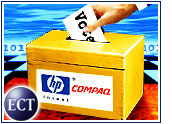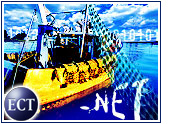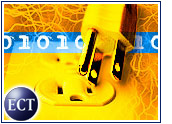
When you think of Intel (Nasdaq: INTC), you cannot help but conjure images of lovable aliens or of the Blue Man Group raising the giant number “4” when the Pentium 4 came out. That is thanks largely to a marketing machine that is as lively as ever, despite this recession-hindered economy.
Even with 2001 revenues expected to fall slightlyshort of the nearly US$34 billion posted in 2000,the Santa Clara, California-based Internetarchitecture leader continues to innovate with paceand determination.
Intel chief executive officer Craig Barrett hasmade it clear that the only way through a recession isby persisting with the introduction of new technology, as seen in this year’s launch of the Pentium 4 microprocessor and a parade of networking and communications products.
The forward-looking mindset at Intel has kept director ofcorporate Internet marketing Shawn Conly very busyduring his five years with the company. Conly recently spokewith the E-Commerce Times about the risks and rewards of using the Internet to forge deeperconnections with customers.
Mixed Messages
ECT: What advertising advantages does theInternet offer that other media do not provide?
Conly: Its primary advantage is the speed offeedback from targets and customers, in terms of howthey are reacting to our messages. That immediateinput is phenomenal and helps us to craft our messagesand strategies towards what pushes the buttons forcustomers.
We find the key strength of the Internet to be at thetail end of the sales curve — when it comes tobuilding preference and conviction and drivingcustomers towards a transaction — versus the frontend of the sales curve, where it’s about awareness.
ECT: What steps, or series of steps, do youtake when planning an online advertising campaign?
Conly: We do it in a holistic way, and take avery disciplined approach to looking at our totalmedia mix and marketing strategy for a particularproduct launch or a new campaign launch. We look athow to use the Internet in conjunction with ouroffline advertising activities and our eventactivities.
The Blue Man Group campaign was one of thebest-integrated campaigns that we’ve ever done, froman offline to an online standpoint. We did everythingfrom retail, to online, to television, to events.
Divvying Dollars
ECT: Should an online advertiser choose manysites on which to advertise — or spend the sameamount for a larger buy on one site?
Conly: When we started doing this in earnestback in 1996 and 1997, we began with a very broad listof sites that we were targeting and running ouradvertising on. Through time, we’ve honed that listdown to the ones that seem to be the most successfulfor certain marketing messages. And we continuallykeep the churn going on with other sites, so we can dosome experimentation. So we keep the sites that aretried-and-true in our portfolio, but we keep lookingfor new ones to compliment those. We want to make surewe’re staying on top of the latest sites and trendsthat are out there.
For some key sites, we see an advantage in creating acustomized interaction between our content and theircontent. And I hope that never goes away, because Ithink that’s the real advantage to the consumer, too.We can marry messages of commonality and giveconsumers information and opportunities that aredirectly related to their areas of interest. We didthis recently with the NCAA basketball finals.
ECT: What process do you use to determine howmuch of your overall advertising budget is allocatedto a particular site?
Conly: In true Intel fashion, we have a verydata-intensive process that we go through, where welook at the reach of the Web site, the demographic andpsychographic makeup of the site, the quality ofcontent on the site, and the exclusivity that we’reoffered in terms of placement on the site. We’ll alsolook at our performance history on the site, not justfrom a click-through standpoint, but from a quality oflead and conversion standpoint.
We put that all into a complex matrix to evaluate our different siteopportunities. And money of course is the other factorto consider.
Experimental Approach
ECT: What are the biggest challenges ofmarketing via interactive media?
Conly: You have to learn by doing in manyinstances, and I think that’s one of the biggestchallenges. Some advertisers wouldn’t have these samechallenges if they stick to the tried-and-true banner,but we tend to push the edges a lot when it comes tousing technology and that creates some complexity.
Intel tends to be very experimental in how we’re usingthe Web. That really gets to the core of what we are,which is a technology company, and we like to usetechnology to sell technology. So we’ve been on theforefront of adopting new advertising deliverytechnologies, whether it’s Flash, superstitials,interstitials or skyscraper banner ads. It’s still anascent industry, and we’ve learned a lot in terms ofhow to do it and how not to do it.
Another challenge is around data and consistency ofdata. We have to take the plethora of data that comesout of this medium and really hone in on what’simportant. You can be swamped in data, so it becomeschallenging for marketing managers to pull out therelevant data details, and to get enough data to beable to make smart decisions without gettingoverwhelmed in the morass of it.
Early in this game, it was all about click rates, and then it was about time spent and transfers to your Web site, and then page views on your Web site from ads you were running. Finally, we’re closing the loop all the way down to conversion and sales. But there still are a lot of inconsistencies in how different sites measure the conversion.
Pushing and Pulling
ECT: How well-suited is the Internet forbranding campaigns?
Conly: It’s one of the rare opportunities whereyou have this one-on-one interaction with customersand prospects. From that standpoint, it’s all aboutbranding because it’s about that experience and howsomebody is interacting with your ad and your site.It’s like having an interaction with a salesperson.
It’s a brand impression. It may not be the TV-ad typeof brand impression, but it’s a more personal brandimpression because it’s that one person at one pointin time interacting with your company and with yourbrand. So from that standpoint, the Internet is agreat brand-builder and a great loyalty-builder.
ECT: How well-suited is the Internet for leadgeneration?
Conly: It’s a very effective method ofcapturing specific target segments and making themaware of your product lines and your messages andgetting them to take the next step with you.
We use the Internet in a variety of spots along the leadgeneration curve, from getting somebody interested, tothe next step of getting more information, to gettingthem to talk to a sales representative, and gettingthose people to actually convert.
Trusty Tools
ECT: What advantages have you gained throughrunning a banner ad campaign?
Conly: The key advantage is one of reach. It’svery easy to get a banner campaign up and spread outacross the Internet very quickly because it isstandardized. On the flip side, it has become in somecases the invisible ad, as people have gotten used tothem and used to blocking them out. It has that downside, but if you need to get something up and get amessage out there quickly, there’s nothing better thana banner.
Please continue to Part 2.












































Social Media
See all Social Media